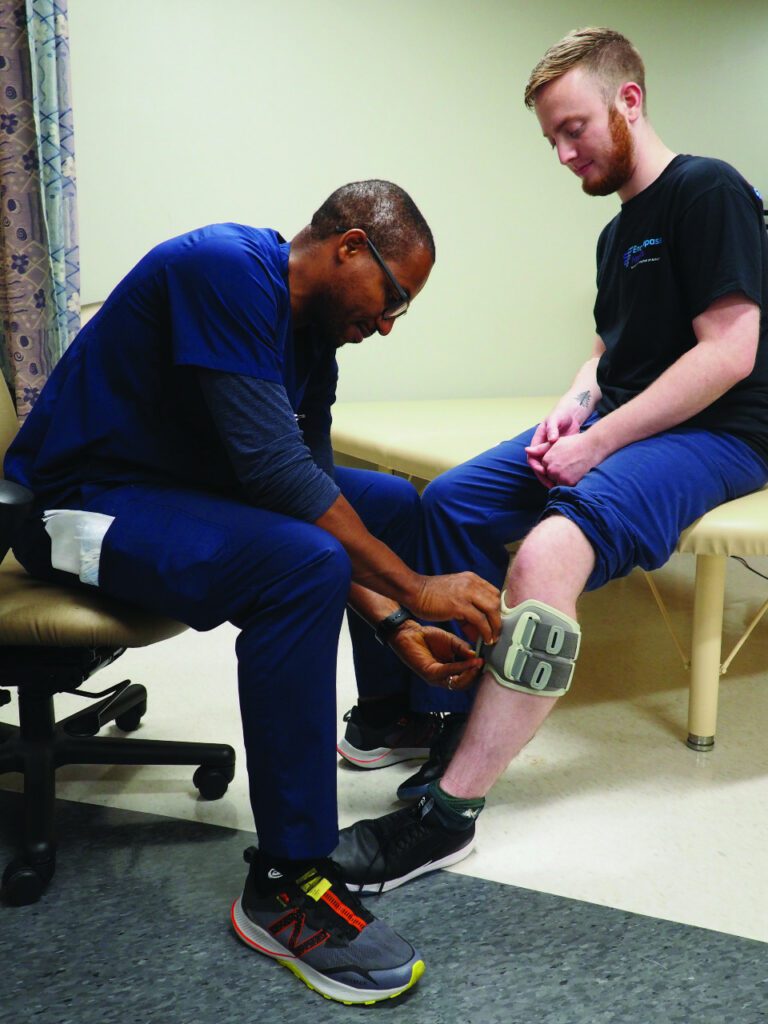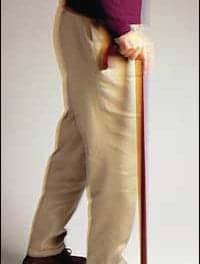CAPTION: Susan Adix, PT Team Leader, and Julie Clement, OT Team Leader at Ecompass Arlington, demonstrate use of a gait training devide in the REAL Therapy Gym.
Today’s neuro therapists have more advanced tools at their disposal to aid in meeting stroke patients’ needs and goals.
by Tracie Hunnicutt, MS, CCC-SLP, Julie Clement, OTR, and Susan Adix, PT
Stroke rehab is a very general and basic description for what is undoubtedly one of the most challenging and rewarding specialties a therapist can pursue. It also belies the heterogeneous nature of stroke, where no two patients are ever truly alike. Functional neuropathology is related directly to which nerves and nerve pathways are damaged, and in what manner they are damaged.
For example, hemorrhagic strokes, which are caused by blood damaging brain tissue, are less common but more likely to be fatal, with 30-day mortality rates of close to 38%. Conversely, ischemic strokes, which comprise up to 87% of all strokes, are caused by blockage of oxygenated blood to brain tissue and are far less likely to be fatal, with a 30-day mortality rate of closer to 11%.1 Both types of stroke can cause severe, chronic functional impairment. In addition to the manner in which the tissue is damaged, the specific nerves and pathways that are impacted dictate whether the patient will have a dense hemiparesis, aphasia, apraxia, proprioception issues, visual deficits, dysphagia, spasticity, poor executive function, vestibular problems, etc. The list of potential problems goes on and on.
Importance of Early Therapy and Skilled Neuro Therapists
Stroke rehab is best described as a continuum. The early hours and days following stroke are heavily focused on medical management of the patient and preserving as much vulnerable brain tissue as possible. Running a close second to the medical management of the patient is the importance of early therapy and mobilization.
Research continues to show us that early initiation of therapy and movement is tied to more positive long-term functional outcomes in stroke patients.2-3 Other studies focused on the appropriate onset and dosing of early therapy for stroke patients tell us that short, frequent therapy sessions beginning soon after the onset of stroke are most highly correlated with improved 3-month functional outcomes.4 As the patient becomes more medically stable and more able to tolerate activity, it is important that both the amount and intensity of therapy increases. Intense rehabilitation therapy—particularly in lower-level, more impaired stroke patients—is correlated with higher levels of functional independence and decreased burden of care.2
There are various post-acute settings in which a patient can receive therapy: inpatient rehabilitation facilities (IRF), long term acute care facilities (LTAC), skilled nursing facilities (SNF), home health (HH), outpatient therapy clinics, etc. While all of these settings offer varying amounts of therapy, inpatient rehab facilities generally offer more frequent and intense therapy services and give the patient a better chance to regain function and independence.
Neuro therapists of any discipline—PT, OT, or SLP—must be expert detectives, expert problem-solvers, and expert encouragers, in addition to the advanced clinical skills required to assess and treat this patient population. Identifying a patient’s functional deficits in self care, mobility, communication, cognition, and swallowing is merely the beginning of the puzzle. With this information in mind, neuro therapists must then collaborate with the patient, family, and one another to develop a treatment plan that takes into account the goals and functional requirements of the patient to be successful in their home environment.
This is where clinical skills mesh with empathy and the ability to look at the big picture of each individual patient. For some patients, the ability to communicate supersedes all other goals. Some patients just want to be able to eat. Others don’t want to have family members help them in the bathroom. Many just want to be able to walk and get around on their own. From the clinical assessment and the collaboration with the patient and family, a treatment plan is born with the purpose of helping each individual patient achieve the goals that matter most to them.

Where Neuroplasticity Meets Rehab Tech
The foundation of stroke rehab lies in the concept of neuroplasticity, which is the ability of the brain to form new pathways and compensate for damaged tissue by “re-routing” certain functions to other areas of the brain. This is most likely to happen successfully when patients begin receiving therapy very soon after their stroke and when the therapy itself mimics the actual activities the patient will be doing at home. This is referred to as task specificity. Given the physical limitations of some stroke patients, as well as the institutional environment of healthcare facilities, task specificity can sometimes be a challenge to neuro therapists. Thankfully, there has been an explosion in the area of rehab-based technologies over the last decade that arms therapists with all kinds of new tools in their therapy toolbox.
In particular, devices with the goal of assisting stroke patients with ambulation have proliferated over the past several years. These devices vary in design, style, cost, and philosophical approach to recovering ambulatory ability. They range from weight-supported ambulation systems that can be used on a treadmill or overground, to robotic exoskeletons and electromechanical-assisted gait devices that mimic normal human movement, to wearable biofeedback units and functional electrical stimulation devices that help the patient regain normal gait patterns. It is an exciting time in stroke rehab, as there are new ideas and technologies being developed continually with the sole aim of improving mobility for stroke patients. These technologies have a growing research base from which they have continued to improve in order to better serve patients.
For example, initial studies on weight-supported treadmill training with stroke patients showed no statistically significant differences in walking speed or level of independence. However, a systematic review of the data several years later found a short-term positive effect on both walking speed and endurance, specifically for patients who were not dependent for ambulation at the start of treatment.5
For lower-level, non-ambulatory stroke patients, there is a general consensus that exoskeletons and electromechanical-assisted gait training may benefit the patient more than conventional pre-gait and gait training.6 In a comparison of various ambulation technologies contrasted with conventional gait therapy, it was found that for both walking speed and distance, devices that offered some electromechanical assistance as well as body weight support were the superior choice for post-stroke ambulation training.6
Another study looked specifically at the use of robotic exoskeletons in comparison to standard gait therapy, and found that patients who utilized the exoskeleton walked twice as far as patients who did not utilize this tool.7 This study also comments on the relationship between repetitive, task-specific therapy, neuroplasticity, and improved functional outcomes, noting that improvement early in post-stroke recovery also leads to better functional independence once the stroke patient transitions from acute recovery to a chronic state.
A different study focused on the use of a robotic device for gait in combination with a virtual reality program. They found that patients who utilized the VR unit as a functional environment setting showed more improvement in community ambulation than patients who used the robotic device alone.8 This result seems to also reinforce what we know about the use of highly contextualized settings such as REAL Therapy (Realistic Environment Applied Learning) or community reintegration therapy, where therapeutic outings take place in the community itself. The use of these functional settings in stroke recovery results in improved patient perception of independence and improved quality of life.
Functional electrical stimulation (FES) is another area of rehab technology that has developed and improved over the years since inception. Initially conceived as a type of “neuro prosthesis” that the patient would wear and utilize throughout their life
post-stroke, FES devices have now also become a common and useful tool in acute stroke recovery. There is evidence that the use of FES in the acute phase of stroke recovery results in improvement of foot drop as well as increased walking speed.9
Much of the research with FES has also shown that one of the serendipitous effects of utilizing the device in conjunction with functional tasks like standing and walking is that the patient improves in the ability to perform these tasks even without the FES device on.9 This is neuroplasticity in action, where task-specific activities in therapy clearly result in effective cortical reorganization with a carryover to more functional independence for the patient.
Overcoming Hurdles
As with all new advances in the medical field, there are hurdles to overcome with implementation of rehab technology. In a study which consulted groups of therapists about the potential development of new rehab technology devices, therapists responded with feedback about the sheer number of devices already available to them; the time it took to set up, use, and clean the devices; whether or not the data generated by the device was useful and practical, as well as the cost to purchase and maintain the device.10 They also noted what has already been commented on earlier in this article, which is the highly individualized nature of stroke rehab based on the patient’s unique deficits, and the need to utilize appropriate technology as it applies to the patient’s goals rather than just for the sake of implementing technology.
Challenges aside, there is no doubt that rehab technology is here to stay and that it has created miraculous success stories for some stroke patients. This will only become more and more common as new devices are created and existing technologies are perfected. Rehab technologies may become the surrogate limbs, joints, and motors of our stroke patients, but what will forever remain the heart of stroke recovery is a dedicated therapist who understands neuroplasticity and is committed to helping their patient regain their independence. RM
Tracie Hunnicutt, MS, CCC-SLP, Therapy Manager, received her training as a speech-language pathologist at Texas Tech University Health Sciences Center. She assisted in the development of the REAL Therapy Gym, and is currently a medical speech language pathologist in inpatient rehabilitation at Encompass Health Rehabilitation Hospital of Arlington in Arlington, Texas.
Julie Clement, OTR, received her training in occupational therapy at the University of Texas Medical Branch. She is currently the OT Team Leader at Encompass Health Rehabilitation Hospital of Arlington, and oversees the specialty wheelchair seating and positioning program.
Susan Adix, PT, received her training as a physical therapist at the University at Buffalo. Adix is currently the PT Team Leader for a staff of more than 30 physical therapists and rehabilitation techs. For more information, contact [email protected].
References
- Xian Y, Holloway RG, Pan W, Peterson ED. Challenges in assessing hospital-level stroke mortality as a quality measure. Stroke. 2012;43:1687-1690.
- Hu M-H, Hsu S-S, Yip P-K, Jeng J-S, Wang Y-H. Early and intensive rehabilitation predicts good functional outcomes in patients admitted to the stroke intensive care unit. Disabil Rehabil. 2010;32(15):1251-1259.
- Herpich F, Rincon F. Management of acute ischemic stroke. Crit Care Med. 2020;48(11):1654-1663.
- Bernhardt J, Churilov L, Ellery F, et al; AVERT Collaboration Group. Prespecified dose-response analysis for a very early rehabilitation trial (AVERT). Neurology. 2016;86(23):2138-2145.
- Mehrholz J, Thomas S, Elsner B. Treadmill training and body weight support for walking after stroke. Cochrane Database Syst Rev. 2017.
- Mehrholz J, Pohl M, Kugler J, Elsner B. The improvement of walking ability following stroke. Dtsch Arztebl Int. 2018;115(39);639-645.
- Nolan KJ, Karunakaran KK, Chervin K, et al. Robotic exoskeleton gait training during acute stroke inpatient rehabilitation. Front Neurorobot. 2020;14:581815.
- Mirelman A, Bonato P, Deutsch JE. Effects of training with a robot-virtual reality system compared with a robot alone on the gait of individuals after stroke. Stroke. 2009;40(1):169-174.
- Marquez-Chin CP, Popovich MR. Functional electrical stimulation therapy for restoration of motor function after spinal cord injury and stroke: a review. Biomed Eng Online. 2020;19(1):34.
- Louie DB, Bird M-L, Menon C, Eng JJ. Perspectives on the prospective development of stroke-specific lower extremity wearable monitoring technology: a qualitative focus group study with physical therapists and individuals with stroke. J Neuroeng Rehabil. 2020;17(1):31.





